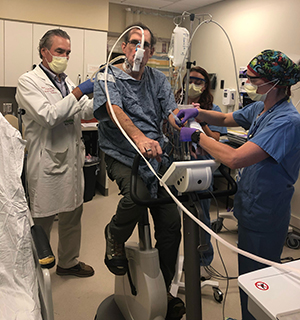
Results of an invasive cardiopulmonary exercise test (iCPET) explain why patients with post-acute COVID-19 syndrome (PACS), also known as long-haul COVID, suffer from fatigue, shortness of breath and lightheadedness when exerting themselves. A recent study published in the journal CHEST found that PACS patients without cardiopulmonary disease demonstrate a marked reduction in aerobic activity and impaired systemic oxygen extraction, along with an exaggerated hyperventilatory response during exercise.
David M. Systrom Jr., MD, of the Brigham and Women’s Hospital Division of Pulmonary and Critical Care Medicine is one of the study’s authors and said that conventional investigative studies cannot readily explain the persistent exertional limitation that these patients face. He has a long-standing interest in understanding the pathophysiology that underlies exercise intolerance of all kinds and initially used iCPET to study myalgic encephalomyelitis/chronic fatigue syndrome (ME/CFS). After discovering the test detected lax blood vessels during exercise, he is now applying it to PACS patients and finding similarities between ME/CFS and PACS.

“The test is a powerful tool to help us determine mechanisms underlying undifferentiated exercise intolerance when traditional examinations, lab work, chest imaging and other tests don’t lead to a definitive diagnosis,” Dr. Systrom said. “Once we sort out the pathophysiology of the condition, we are in a better position to treat it.”
Reduced Peak Exercise Aerobic Capacity Found in PACS Patients
Recent evidence has shown that persistent physical symptoms such as fatigue, dyspnea, chest pain, cough and neurocognitive complaints are common following acute COVID-19. A subset of patients has post-COVID long-haul syndrome, which includes a decrease in exercise capacity. To treat these patients, clinicians need to understand the pathophysiologic basis for the persistent exertional and functional limitation.
In the study published in CHEST, the invasive CPET on PACS patients started with a right heart catheterization in the supine position. A 5-port pacing pulmonary artery catheter was inserted percutaneously under fluoroscopic and ultrasound guidance into the internal jugular vein, with a second catheter concurrently placed in the radial artery. Patients underwent a symptom-limited incremental CPET using an upright cycle ergometer with a breath-by-breath assessment of ventilation and gas exchange along with continuous 12-lead electrocardiogram monitoring.
The study found that PACS patients exhibited markedly reduced peak exercise aerobic capacity (VO2) compared to controls. This reduction in peak VO2 was associated with impaired systemic oxygen extraction (i.e., narrow Ca-vO2/CaO2) compared to controls with a preserved peak cardiac index. Additionally, post-COVID-19 patients demonstrated greater ventilatory inefficiency (i.e., abnormal VE/VCO2) compared to controls from a heightened chemoreflex sensitivity rather than increased dead space ventilation.
“Exercise limitation is a common manifestation of post-COVID-19 syndrome months following resolution of mild acute COVID-19 illness,” Dr. Systrom said. “Our study confirmed that vascular dysregulation and impaired oxygen extraction are hallmarks of exercise dysfunction in these patients.”
Developing Precise Post-COVID Treatment Plans
With an improved pathophysiological understanding of PACS, clinicians will be in a better position to treat the condition. According to Dr. Systrom, clinicians treating PACS-induced exercise intolerance can look to the standard of treatment for postural orthostatic tachycardia syndrome, a disorder of the autonomic nervous system.
Medications such as midodrine may be prescribed, along with off-label use of pyridostigmine, which enhances sympathetic and nervous system outflow to blood vessels, restoring some of their normal function. Other potential treatment modalities, including an antioxidant vitamin cocktail called the “Mito Cocktail,” may be prescribed for patients with significantly impaired system oxygen extraction tied to an element of mitochondrial dysfunction in the muscle.
“The Brigham is committed to developing precise treatment plans for new and old illnesses alike,” Dr. Systrom said. “Our ability to marry basic science and medicine and approach diseases in a systematic method is unparalleled and receives full-blown support from the top down.”